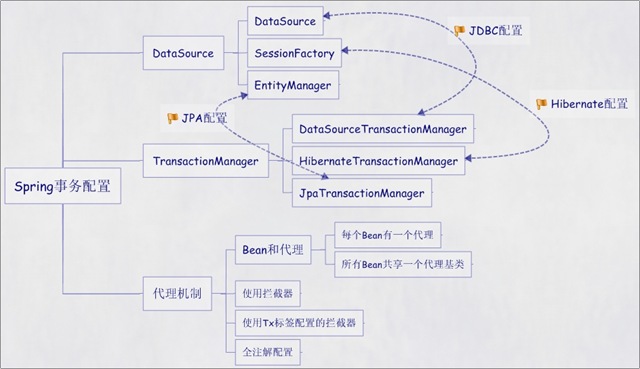SSH深度历险(六) 深入浅出----- Spring事务配置的五种方式
这对时间在学习SSH中Spring架构,Spring的事务配置做了详细总结,在此之间对Spring的事务配置只是停留在听说的阶段,总结一下,整体把控,通过这次的学习发觉Spring的事务配置只要把思路理清,还是比较好掌握的。
总结如下:
Spring配置文件中关于事务配置总是由三个组成部分,分别是DataSource、TransactionManager和代理机制这三部分,无论哪种配置方式,一般变化的只是代理机制这部分。
DataSource、TransactionManager这两部分只是会根据数据访问方式有所变化,比如使用Hibernate进行数据访问时,DataSource实际为SessionFactory,TransactionManager的实现为HibernateTransactionManager。
具体如下图:

根据代理机制的不同,总结了五种Spring事务的配置方式,配置文件如下:
第一种方式:每个Bean都有一个代理
<span style="font-size:18px;"><span style="font-size:18px;"><?xml version="1.0" encoding="UTF-8"?>
<beans xmlns="http://www.springframework.org/schema/beans"
xmlns:xsi="http://www.w3.org/2001/XMLSchema-instance"
xmlns:context="http://www.springframework.org/schema/context"
xmlns:aop="http://www.springframework.org/schema/aop"
xsi:schemaLocation="http://www.springframework.org/schema/beans
http://www.springframework.org/schema/beans/spring-beans-2.5.xsd
http://www.springframework.org/schema/context
http://www.springframework.org/schema/context/spring-context-2.5.xsd
http://www.springframework.org/schema/aop http://www.springframework.org/schema/aop/spring-aop-2.5.xsd"> <bean id="sessionFactory"
class="org.springframework.orm.hibernate3.LocalSessionFactoryBean">
<property name="configLocation" value="classpath:hibernate.cfg.xml" />
<property name="configurationClass" value="org.hibernate.cfg.AnnotationConfiguration" />
</bean> <!-- 定义事务管理器(声明式的事务) -->
<bean id="transactionManager"
class="org.springframework.orm.hibernate3.HibernateTransactionManager">
<property name="sessionFactory" ref="sessionFactory" />
</bean> <!-- 配置DAO -->
<bean id="userDaoTarget" class="com.bluesky.spring.dao.UserDaoImpl">
<property name="sessionFactory" ref="sessionFactory" />
</bean> <bean id="userDao"
class="org.springframework.transaction.interceptor.TransactionProxyFactoryBean">
<!-- 配置事务管理器 -->
<property name="transactionManager" ref="transactionManager" />
<property name="target" ref="userDaoTarget" />
<property name="proxyInterfaces" value="com.bluesky.spring.dao.GeneratorDao" />
<!-- 配置事务属性 -->
<property name="transactionAttributes">
<props>
<prop key="*">PROPAGATION_REQUIRED</prop>
</props>
</property>
</bean>
</beans></span></span>
第二种方式:所有Bean共享一个代理基类
<span style="font-size:18px;"><span style="font-size:18px;"><span style="font-size:18px;"><?xml version="1.0" encoding="UTF-8"?>
<beans xmlns="http://www.springframework.org/schema/beans"
xmlns:xsi="http://www.w3.org/2001/XMLSchema-instance"
xmlns:context="http://www.springframework.org/schema/context"
xmlns:aop="http://www.springframework.org/schema/aop"
xsi:schemaLocation="http://www.springframework.org/schema/beans
http://www.springframework.org/schema/beans/spring-beans-2.5.xsd
http://www.springframework.org/schema/context
http://www.springframework.org/schema/context/spring-context-2.5.xsd
http://www.springframework.org/schema/aop http://www.springframework.org/schema/aop/spring-aop-2.5.xsd"> <bean id="sessionFactory"
class="org.springframework.orm.hibernate3.LocalSessionFactoryBean">
<property name="configLocation" value="classpath:hibernate.cfg.xml" />
<property name="configurationClass" value="org.hibernate.cfg.AnnotationConfiguration" />
</bean> <!-- 定义事务管理器(声明式的事务) -->
<bean id="transactionManager"
class="org.springframework.orm.hibernate3.HibernateTransactionManager">
<property name="sessionFactory" ref="sessionFactory" />
</bean> <bean id="transactionBase"
class="org.springframework.transaction.interceptor.TransactionProxyFactoryBean"
lazy-init="true" abstract="true">
<!-- 配置事务管理器 -->
<property name="transactionManager" ref="transactionManager" />
<!-- 配置事务属性 -->
<property name="transactionAttributes">
<props>
<prop key="*">PROPAGATION_REQUIRED</prop>
</props>
</property>
</bean> <!-- 配置DAO -->
<bean id="userDaoTarget" class="com.bluesky.spring.dao.UserDaoImpl">
<property name="sessionFactory" ref="sessionFactory" />
</bean> <bean id="userDao" parent="transactionBase" >
<property name="target" ref="userDaoTarget" />
</bean>
</beans></span></span></span>
第三种方式:使用拦截器
<span style="font-size:18px;"><span style="font-size:18px;"><span style="font-size:18px;"><?xml version="1.0" encoding="UTF-8"?>
<beans xmlns="http://www.springframework.org/schema/beans"
xmlns:xsi="http://www.w3.org/2001/XMLSchema-instance"
xmlns:context="http://www.springframework.org/schema/context"
xmlns:aop="http://www.springframework.org/schema/aop"
xsi:schemaLocation="http://www.springframework.org/schema/beans
http://www.springframework.org/schema/beans/spring-beans-2.5.xsd
http://www.springframework.org/schema/context
http://www.springframework.org/schema/context/spring-context-2.5.xsd
http://www.springframework.org/schema/aop http://www.springframework.org/schema/aop/spring-aop-2.5.xsd"> <bean id="sessionFactory"
class="org.springframework.orm.hibernate3.LocalSessionFactoryBean">
<property name="configLocation" value="classpath:hibernate.cfg.xml" />
<property name="configurationClass" value="org.hibernate.cfg.AnnotationConfiguration" />
</bean> <!-- 定义事务管理器(声明式的事务) -->
<bean id="transactionManager"
class="org.springframework.orm.hibernate3.HibernateTransactionManager">
<property name="sessionFactory" ref="sessionFactory" />
</bean> <bean id="transactionInterceptor"
class="org.springframework.transaction.interceptor.TransactionInterceptor">
<property name="transactionManager" ref="transactionManager" />
<!-- 配置事务属性 -->
<property name="transactionAttributes">
<props>
<prop key="*">PROPAGATION_REQUIRED</prop>
</props>
</property>
</bean> <bean class="org.springframework.aop.framework.autoproxy.BeanNameAutoProxyCreator">
<property name="beanNames">
<list>
<value>*Dao</value>
</list>
</property>
<property name="interceptorNames">
<list>
<value>transactionInterceptor</value>
</list>
</property>
</bean> <!-- 配置DAO -->
<bean id="userDao" class="com.bluesky.spring.dao.UserDaoImpl">
<property name="sessionFactory" ref="sessionFactory" />
</bean>
</beans></span></span></span>
第四种方式:使用tx标签配置的拦截器
<span style="font-size:18px;"><span style="font-size:18px;"><span style="font-size:18px;"><?xml version="1.0" encoding="UTF-8"?>
<beans xmlns="http://www.springframework.org/schema/beans"
xmlns:xsi="http://www.w3.org/2001/XMLSchema-instance"
xmlns:context="http://www.springframework.org/schema/context"
xmlns:aop="http://www.springframework.org/schema/aop"
xmlns:tx="http://www.springframework.org/schema/tx"
xsi:schemaLocation="http://www.springframework.org/schema/beans
http://www.springframework.org/schema/beans/spring-beans-2.5.xsd
http://www.springframework.org/schema/context
http://www.springframework.org/schema/context/spring-context-2.5.xsd
http://www.springframework.org/schema/aop http://www.springframework.org/schema/aop/spring-aop-2.5.xsd
http://www.springframework.org/schema/tx http://www.springframework.org/schema/tx/spring-tx-2.5.xsd"> <context:annotation-config />
<context:component-scan base-package="com.bluesky" /> <bean id="sessionFactory"
class="org.springframework.orm.hibernate3.LocalSessionFactoryBean">
<property name="configLocation" value="classpath:hibernate.cfg.xml" />
<property name="configurationClass" value="org.hibernate.cfg.AnnotationConfiguration" />
</bean> <!-- 定义事务管理器(声明式的事务) -->
<bean id="transactionManager"
class="org.springframework.orm.hibernate3.HibernateTransactionManager">
<property name="sessionFactory" ref="sessionFactory" />
</bean> <tx:advice id="txAdvice" transaction-manager="transactionManager">
<tx:attributes>
<tx:method name="*" propagation="REQUIRED" />
</tx:attributes>
</tx:advice> <aop:config>
<aop:pointcut id="interceptorPointCuts"
expression="execution(* com.bluesky.spring.dao.*.*(..))" />
<aop:advisor advice-ref="txAdvice"
pointcut-ref="interceptorPointCuts" />
</aop:config>
</beans></span></span></span>
第五种方式:全注解
<span style="font-size:18px;"><span style="font-size:18px;"><span style="font-size:18px;"><?xml version="1.0" encoding="UTF-8"?>
<beans xmlns="http://www.springframework.org/schema/beans"
xmlns:xsi="http://www.w3.org/2001/XMLSchema-instance"
xmlns:context="http://www.springframework.org/schema/context"
xmlns:aop="http://www.springframework.org/schema/aop"
xmlns:tx="http://www.springframework.org/schema/tx"
xsi:schemaLocation="http://www.springframework.org/schema/beans
http://www.springframework.org/schema/beans/spring-beans-2.5.xsd
http://www.springframework.org/schema/context
http://www.springframework.org/schema/context/spring-context-2.5.xsd
http://www.springframework.org/schema/aop http://www.springframework.org/schema/aop/spring-aop-2.5.xsd
http://www.springframework.org/schema/tx http://www.springframework.org/schema/tx/spring-tx-2.5.xsd"> <context:annotation-config />
<context:component-scan base-package="com.bluesky" /> <tx:annotation-driven transaction-manager="transactionManager"/> <bean id="sessionFactory"
class="org.springframework.orm.hibernate3.LocalSessionFactoryBean">
<property name="configLocation" value="classpath:hibernate.cfg.xml" />
<property name="configurationClass" value="org.hibernate.cfg.AnnotationConfiguration" />
</bean> <!-- 定义事务管理器(声明式的事务) -->
<bean id="transactionManager"
class="org.springframework.orm.hibernate3.HibernateTransactionManager">
<property name="sessionFactory" ref="sessionFactory" />
</bean> </beans></span></span></span>
此时在DAO上需加上@Transactional注解,如下:
<span style="font-size:18px;"><span style="font-size:18px;"><span style="font-size:18px;">package com.bluesky.spring.dao; import java.util.List; import org.hibernate.SessionFactory;
import org.springframework.beans.factory.annotation.Autowired;
import org.springframework.orm.hibernate3.support.HibernateDaoSupport;
import org.springframework.stereotype.Component; import com.bluesky.spring.domain.User; @Transactional
@Component("userDao")
public class UserDaoImpl extends HibernateDaoSupport implements UserDao { public List<User> listUsers() {
return this.getSession().createQuery("from User").list();
} }</span></span></span>
总结
XML配置方式
优点:
1. XML配置方式进一步降低了耦合,使得应用更加容易扩展,即使对配置文件进一步修改也不需要工程进行修改和重新编译。
2.在处理大的业务量的时候,用XML配置应该更加好一些。因为XML更加清晰的表明了各个对象之间的关系,各个业务类之间的调用。同时spring的相关配置也能一目了然。
当然,有人会说,用XML配置,在大的业务量时候会使得XML文件过大,不容易查看。这一点我们完全可以利用业务分解书写多个XML配置文件就可以了。
缺点:
配置文件读取和解析需要花费一定的时间,配置文件过多的时候难以管理,无法对配置的正确性进行校验,增加了测试难度。
annotation配置的优缺点:
优点:
1. 在class文件中,可以降低维护成本,annotation的配置机制很明显简单
2. 不需要第三方的解析工具,利用java反射技术就可以完成任务
3. 编辑期可以验证正确性,差错变得容易
4. 提高开发效率
缺点:
1. 如果需要对于annotation进行修改,那么要重新编译整个工程
2. 业务类之间的关系不如XML配置那样容易把握。
3. 如果在程序中annotation比较多,直接影响代码质量,对于代码的简洁度有一定的影响。
SSH内容很多,先从宏观把控,在项目中历练……多多总结、思路清晰;为了提高系统的灵活性与降低维护成本,提高效率使用到了很多的配置文件来回调用、返回,涉及到很多联系,这个时候真的有必要画图,一切尽在图中展示吧,画出自己的思维方式。
SSH深度历险(六) 深入浅出----- Spring事务配置的五种方式的更多相关文章
- Spring事务配置的五种方式(转发)
Spring事务配置的五种方式(原博客地址是http://www.blogjava.net/robbie/archive/2009/04/05/264003.html)挺好的,收藏转发 前段时间对Sp ...
- Spring事务配置的五种方式和spring里面事务的传播属性和事务隔离级别
转: http://blog.csdn.net/it_man/article/details/5074371 Spring事务配置的五种方式 前段时间对Spring的事务配置做了比较深入的研究,在此之 ...
- Spring事务配置的五种方式(转载)
Spring配置文件中关于事务配置总是由三个组成部分,分别是DataSource.TransactionManager和代理机制这三部分,无论哪种配置方式,一般变化的只是代理机制这部分. DataSo ...
- Spring事务配置的五种方式
Spring配置文件中关于事务配置总是由三个组成部分,分别是DataSource.TransactionManager和代理机制这三部分,无论哪种配置方式,一般变化的只是代理机制这部分. DataSo ...
- Spring事务配置的五种方式 -- 越往后需要Spring版本越高
第五种 基本零配置 个人感觉第四种也可以 Spring配置文件中关于事务配置总是由三个组成部分,分别是DataSource.TransactionManager和代理机制这三部分,无论哪种配置方式, ...
- Spring事务配置的五种方式(转)
前段时间对Spring的事务配置做了比较深入的研究,在此之间对Spring的事务配置虽说也配置过,但是一直没有一个清楚的认识.通过这次的学习发觉Spring的事务配置只要把思路理清,还是比较好掌握的. ...
- Spring事务配置的五种方式 巨全!不看后悔,一看必懂!
前段时间对Spring的事务配置做了比较深入的研究,在此之间对Spring的事务配置虽说也配置过,但是一直没有一个清楚的认识.通过这次的学习发觉Spring的事务配置只要把思路理清,还是比较好掌握的. ...
- (转)Spring事务配置的五种方式
前段时间对Spring的事务配置做了比较深入的研究,在此之间对Spring的事务配置虽说也配置过,但是一直没有一个清楚的认识.通过这次的学习发觉Spring的事务配置只要把思路理清,还是比较好掌握的. ...
- [JavaEE] Spring事务配置的五种方式
前段时间对Spring的事务配置做了比较深入的研究,在此之间对Spring的事务配置虽说也配置过,但是一直没有一个清楚的认识.通过这次的学习发觉Spring的事务配置只要把思路理清,还是比较好掌握的. ...
随机推荐
- bzoj 3174: [Tjoi2013]拯救小矮人
Description 一群小矮人掉进了一个很深的陷阱里,由于太矮爬不上来,于是他们决定搭一个人梯.即:一个小矮人站在另一小矮人的 肩膀上,知道最顶端的小矮人伸直胳膊可以碰到陷阱口.对于每一个小矮人, ...
- [bzoj1566][NOI2009]管道取珠
来自FallDream的博客,未经允许,请勿转载,谢谢. n<=500 神题...... 发现这个平方可以看作两个序列相同的对数 然后就可以表示状态了. f[i][j][k]表示两个序列各选了 ...
- [Codeforces Round#417 Div.2]
来自FallDream的博客,未经允许,请勿转载,谢谢. 有毒的一场div2 找了个1300的小号,结果B题题目看错没交 D题题目剧毒 E题差了10秒钟没交上去. 233 ------- A.Sag ...
- 机器学习基础—集成学习Bagging 和 Boosting
集成学习 就是不断的通过数据子集形成新的规则,然后将这些规则合并.bagging和boosting都属于集成学习.集成学习的核心思想是通过训练形成多个分类器,然后将这些分类器进行组合. 所以归结为(1 ...
- 笔记11 在XML中声明切面(2)
为通知传递参数 1.声明一个CompactDiscs接口.内部包含两个方法: show() 用于显示唱片的名字和艺术风格 playTrack(int number) 根据传入的磁道数播放相应磁道的音乐 ...
- python中str常用操作
1. 字符串的操作 字符串的连接操作 符号: + 格式:str1 + str2 例如:str1 = 'I Love' str2 = 'You!' print(str1 + str2) >> ...
- python2.7练习小例子(一)
1)题目:有四个数字:1.2.3.4,能组成多少个互不相同且无重复数字的三位数?各是多少? 程序分析:可填在百位.十位.个位的数字都是1.2.3.4.组成所有的排列后再去掉不满足条件的 ...
- net use命令详解
net use命令详解 1)建立空连接: net use \\IP\ipc$ "" /user:"" (一定要注意:这一行命令中包含了3个空格) 2)建立非空连 ...
- JSON.parse()在火狐中的BUG
//用sessionStorage解决load页面刷新问题 { //sessionStorage.removeItem("loadInfo"); var loadInfo=de ...
- 混合式应用开发之Cordova+vue(1)
一.Cordova创建应用 cordova create oneApp Cordova创建应用出错 Cordova安装时不能使用cnpm 应该使用npm,cnpm虽然快但是后期出的错绝对比这省下来的时 ...
